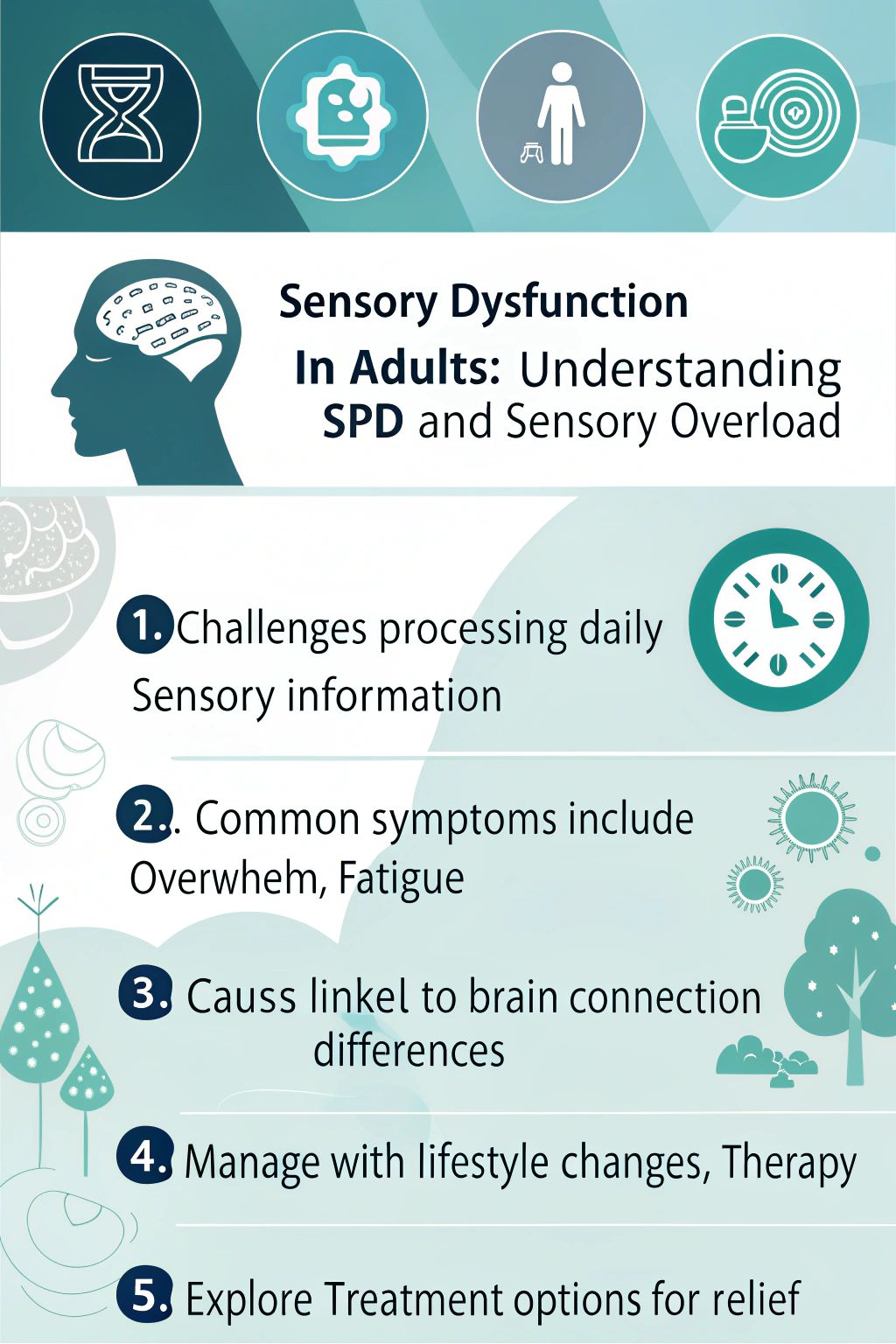Many individuals may find certain stimuli disconcerting or overpowering. This could entail discomfort in crowded areas, difficulty with the feel of specific foods, or a sense of perturbation by loud sounds.
These instances might indicate sensory dysfunction in adults, a condition that often proves challenging to identify but significantly impacts everyday routines.
A substantial detail regarding this subject is that Sensory Processing Disorder (SPD) is a neurological condition where the brain struggles with managing information received from our senses.
Our article will give you an understanding of SPD and managing sensory overload while supplying beneficial advice for those managing these difficulties. Prepare to enhance your everyday experiences.

What is Sensory Dysfunction in Adults?

Sensory dysfunction in adults, known as sensory processing disorder (SPD), is a condition characterised by the brain’s difficulty in managing sensory information like sights, sounds, tastes, smells, and touch.
This complexity with sensory input often leads to disruptions in everyday activities and interactions for adults struggling with SPD.
SPD influences not just our sensory perception of our surroundings, but also our ability to thrive within it.
This disorder manifests in numerous ways, for instance, having a heightened sensitivity to textures or noises. This matters as it relates closely to other disorders such as ADHD and autism spectrum disorders.
Individuals with SPD encounter obstacles that heavily affect their relationships, learning capabilities, and personal aspirations.
Understanding Sensory Processing Disorder (SPD)
Sensory Processing Disorder (SPD) in adults involves atypical processing of sensory input, affecting how individuals perceive and respond to various stimuli. SPD can manifest as hypersensitivity or hyposensitivity to sensory information, impacting daily functioning and emotional well-being.
For instance, individuals with SPD may struggle with regulating responses to sound, touch, taste, smell, or visual input.
Key symptoms of SPD in adults
Adults with Sensory Processing Disorder (SPD) often face daily challenges. Their symptoms can greatly affect their lives at home and work.
- Many adults report feeling overwhelmed by normal sights, sounds, textures, and smells. This heightened sensitivity can make ordinary environments seem unbearable.
- They may describe feelings of being “assaulted” by everyday sensory experiences that others find normal or unremarkable.
- Difficulty concentrating in environments with background noise or visual distractions becomes a huge obstacle. It can hinder performance at work or in social settings.
- Headaches and muscle tension are common physical responses to sensory overload. These symptoms can result from prolonged exposure to overwhelming sensory stimuli.
- Emotional numbness or irritability often follows periods of sensory stress. This can strain personal relationships and lead to social withdrawal.
- Insomnia or fatigue may develop as a result of constant overstimulation. Restful sleep becomes hard to achieve when the brain struggles to ignore sensory inputs.
- Adults might exhibit preferences for loose clothing due to discomfort with certain textures against their skin. Tight or textured fabrics can feel restrictive and uncomfortable.
- The use of noise-cancelling headphones is a strategy some adults adopt to manage auditory sensitivity in noisy environments.
- Discomfort with physical affection and avoidance of crowded areas like malls or concerts are telltale signs of SPD. They limit exposure to overwhelming tactile and auditory stimuli, respectively.
- Some individuals show an aversion to flash photography and strongly scented areas due to their intense reactions to bright lights and strong odours.
These key symptoms highlight how SPD affects not only the sensory experience but also impacts daily functioning, social interactions, and overall quality of life for adults dealing with this disorder.
Common causes of SPD
Several factors can lead to sensory processing disorder (SPD) in adults. Issues during prenatal stages, such as stress in parents and substance use before birth, play a significant role.
These early challenges affect the developing brain, setting the stage for SPD. Birth complications also contribute to SPD risks. Babies born with low weight or too early often face a higher chance of having SPD.
Research using powerful brain scans like functional magnetic resonance imaging shows that people with SPD have different brain connections compared to those without it. This difference points to a neurological underpinning for why some adults struggle more with processing sensory information from their environment.
The evidence suggests our brains might mishandle the signals from our senses, leading to trouble moving smoothly, responding appropriately emotionally, or building relationships easily.
What is Sensory Overload?
Sensory overload occurs when the brain receives more input from the sensory system than it can process effectively, leading to feelings of being overwhelmed. This can manifest as irritability, difficulty concentrating, or even physical discomfort in response to environmental stimuli such as bright lights, loud noises, or strong smells.
Signs of sensory overload
Sensory overload affects many adults, causing discomfort and anxiety. It happens when one or more of the senses get overwhelmed by too much stimulation. Here are signs that someone might be experiencing sensory overload:
- Anxiety often shows up first. People feel nervous or unusually worried without a clear reason.
- Stress levels rise quickly. Small problems seem much bigger, making it hard to relax.
- Difficulty concentrating makes it tough to focus on tasks at work or at home.
- Headaches become frequent, adding physical pain to mental discomfort.
- Muscle tension is common, leading to soreness in the neck, shoulders, and back.
- Irritability increases. Little annoyances cause significant anger or frustration.
- Emotional numbness can set in, making individuals feel disconnected from their surroundings.
- Fatigue takes over because the body and mind are constantly on high alert.
- Insomnia occurs when it’s hard to fall asleep or stay asleep due to ongoing stress.
These symptoms can lead people to avoid certain places or situations that trigger their sensory overload. This avoidance can affect their social life, work performance, and overall happiness. Managing these triggers is key to reducing episodes of sensory overload.
Triggers of sensory overload
Sensory overload affects many people, causing discomfort and distress. It often happens when the brain can’t process all the input it’s getting. Here are common triggers:
- Loud environments, like crowded restaurants or cinemas, bombard the ears with too much noise.
- Bright lights in places like grocery stores strain the eyes.
- Strong odours, such as perfume, can overwhelm the sense of smell.
- Crowds create a flurry of activity that confuses many senses at once.
- Hair brushing might feel too intense for some individuals.
- Tight or coarse clothing irritates the skin by being too close or rough.
- Tags in clothing poke and scratch against the skin, causing irritation.
- Wearing shoes feels restrictive and uncomfortable for some people.
- Sticky textures bother those who find them unpleasant to touch.
- Physical contact might be too stimulating or unwelcome for some.
- Swimming in natural water bodies poses challenges with unpredictable textures and temperatures.
- Specific food textures or tastes trigger negative reactions in certain individuals.
These triggers make everyday situations challenging for those experiencing sensory overload.
Managing Sensory Dysfunction and Overload
To address sensory dysfunction and overload in adults, people can make lifestyle changes to limit exposure to sensory triggers and establish a more relaxing environment. Utilising coping methods like deep breathing exercises, mindfulness meditation, or using noise-cancelling headphones can also aid in relieving sensory overload. Seeking guidance from mental health professionals or occupational therapists who specialise in sensory processing disorders for personalised treatment approaches and support is essential.
Lifestyle adjustments
Managing sensory issues requires practical steps. These changes can help adults with Sensory Processing Disorder (SPD) improve their daily lives.
- Wear comfortable clothing to reduce skin irritation and discomfort. This simple change can make a big difference for those who are sensitive to textures.
- Create sensory-friendly zones in your home where you can retreat when feeling overwhelmed. This area should have soft lighting, minimal noise, and calming colours.
- Exercise regularly to help manage stress and improve overall mental health. Activities like walking or swimming can be especially beneficial.
- Use sunglasses outdoors to protect against harsh sunlight that might overwhelm your sense of sight.
- Employ earplugs or noise-cancelling headphones in noisy environments to block out overwhelming sounds. This can be particularly useful in public spaces or at work.
- Schedule regular breaks throughout the day to prevent sensory overload. Brief periods of quiet or solitude can help reset your senses.
- Practice rhythmic pressure movements, such as rocking or swaying, to soothe the nervous system. These actions can act as a physical way to cope with sensory stress.
- Engage in calming activities like meditation, yoga, or deep breathing exercises. They promote relaxation and mental clarity.
- Identify personal triggers that lead to sensory overload. Knowing what specific sights, sounds, or situations cause discomfort allows you to avoid them when possible.
- Seek community support from others who experience similar challenges with SPD. Sharing experiences and coping strategies can provide comfort and practical advice.
Implementing these lifestyle adjustments offers adults with SPD tools to manage their sensory challenges more effectively.
Coping strategies for sensory overload
Sensory overload can make life challenging for adults with sensory processing issues, so it’s advantageous to find techniques that can provide effective management. Here are some strategies:
- Organise calming, sensory-friendly regions in your residence that can offer relaxation. These areas should be equipped with mellow illumination and minimum disruption.
- Employ the use of noise-cancelling headphones or earplugs in sound-intense surroundings to prevent undesired sounds.
- Retain a ‘sensory toolkit‘ at your disposal, packed with gadgets that aid in providing relaxation, such as stress balls or fidget toys.
- Pencil in regular intervals throughout the day for ‘sensory downtime‘. This contributes to the healing of your nervous system.
- Recognise what causes your sensory overload. Once identified, you can make an effort to circumvent these triggers or equip yourself better.
- Engage in deep respiration exercises or meditation to help pacify your mind when experiencing an influx of feelings.
- Aim to get adequate sleep each night. A sleep deficit can exacerbate sensory processing issues.
- Control the quantity of stimulating activities in your day to avoid overwhelming yourself.
- Establish explicit boundaries with individuals concerning your requirements and limits around sensory interaction.
- Ask for help from a group of individuals who comprehend what you’re experiencing. Trading methods and experiences can be greatly beneficial.
These strategies aspire to lessen the burden of sensory overload on everyday life, offering pragmatic methods to handle symptoms and enrich overall wellness.
Treatment Options for SPD
Therapy approaches play a vital role in addressing sensory processing disorder (SPD), providing tailored interventions to help individuals effectively manage their sensory challenges. Furthermore, exploring medication and alternative treatments under the guidance of healthcare professionals can offer comprehensive support in alleviating symptoms and enhancing daily functioning.
Therapy approaches
Sensory processing disorder (SPD) in adults can be effectively managed through various therapy approaches. The following methods and strategies have been found to be beneficial for addressing sensory dysfunction in adults:
- Sensory Integration Therapy: This therapy aims to improve the brain’s ability to process and integrate sensory information through structured activities and exercises.
- Occupational Therapy: Occupational therapists work with individuals to develop skills for daily living, work, and play by addressing sensory challenges within these contexts.
- Sensory Diets: Tailored programmes of sensory input are designed to meet an individual’s specific sensory needs, promoting self-regulation and reducing sensory sensitivity.
- Therapeutic Listening: Utilising sound-based therapies to address auditory hypersensitivity and promote improved auditory processing.
- Speech Therapy: Targeting communication difficulties related to sensory issues, aiding in developing effective communication strategies.
These therapy approaches provide a range of interventions aimed at improving sensory processing and managing symptoms associated with SPD in adults.
Medication and alternative treatments
Sensory processing disorder (SPD) in adults can be effectively managed with a variety of medical interventions and alternative treatments. Here are some options to consider:
- Therapy Approaches: Several therapy approaches, such as cognitive behavioural therapy, may be beneficial for managing SPD symptoms.
- Antidepressants: Some individuals may find relief from specific symptoms through the use of antidepressant medications.
- Neurological Interventions: Certain neurological interventions, like vagal nerve stimulation, have shown promise in alleviating sensory dysfunction symptoms.
- Sensorimotor Techniques: Alternative treatments such as sensory integration techniques and sensory diets are crucial components of SPD management.
- Lifestyle Adjustments: Personalised self-care strategies, including relaxation techniques and engaging in creative projects, can significantly contribute to well-being.
These medication and alternative treatment options aim to reduce the impact of sensory processing disorder on daily life and provide individuals with effective ways to manage their symptoms more effectively.
Conclusion
Understanding sensory differences in adults, particularly Sensory Processing Disorder (SPD) and sensory overwhelm, is vital for promoting awareness and support. Effective management strategies, including lifestyle adjustments and coping techniques, can significantly enhance daily functioning for individuals experiencing these challenges.
By recognising the symptoms of sensory overwhelm and seeking appropriate treatment options tailored to individual needs, it becomes possible to navigate daily life with greater ease and comfort.
Incorporating practical tips such as using noise-cancelling headphones or engaging in grounding activities can offer relief from overwhelming sensory experiences. It’s noteworthy that each person’s experience with SPD and sensory overwhelm is unique; however, by fostering understanding and empathy within society, we can create a more inclusive environment for individuals dealing with these conditions.
Furthermore, ongoing research in the field aims to expand our understanding of sensory differences in adults, leading to enhanced support systems and advancements in treatment options.
Through continued education on this topic and the development of tailored interventions targeting SPD and sensory overwhelm specifically in adults, we can help promote an improved quality of life for those affected while fostering a more inclusive society overall.
References
- https://www.additudemag.com/sensory-processing-disorder-in-adults/
- https://familydoctor.org/condition/sensory-processing-disorder-spd/
- https://www.medicalnewstoday.com/articles/sensory-overload
- https://neurodivergentinsights.com/blog/sensory-issues-in-adults
- https://www.healthline.com/health/sensory-overload
- https://www.sensoryfriendly.net/how-to-manage-sensory-overload-in-adults/ (2021-08-15)
- https://pmc.ncbi.nlm.nih.gov/articles/PMC8432132/
- https://sensoryhealth.org/basic/treatment-for-adults-sensory-challenges
- https://www.healthline.com/health/mental-health/sensory-processing-disorder-in-adults
MindOwl Founder – My own struggles in life have led me to this path of understanding the human condition. I graduated with a bachelor’s degree in philosophy before completing a master’s degree in psychology at Regent’s University London. I then completed a postgraduate diploma in philosophical counselling before being trained in ACT (Acceptance and commitment therapy).
I’ve spent the last eight years studying the encounter of meditative practices with modern psychology.

